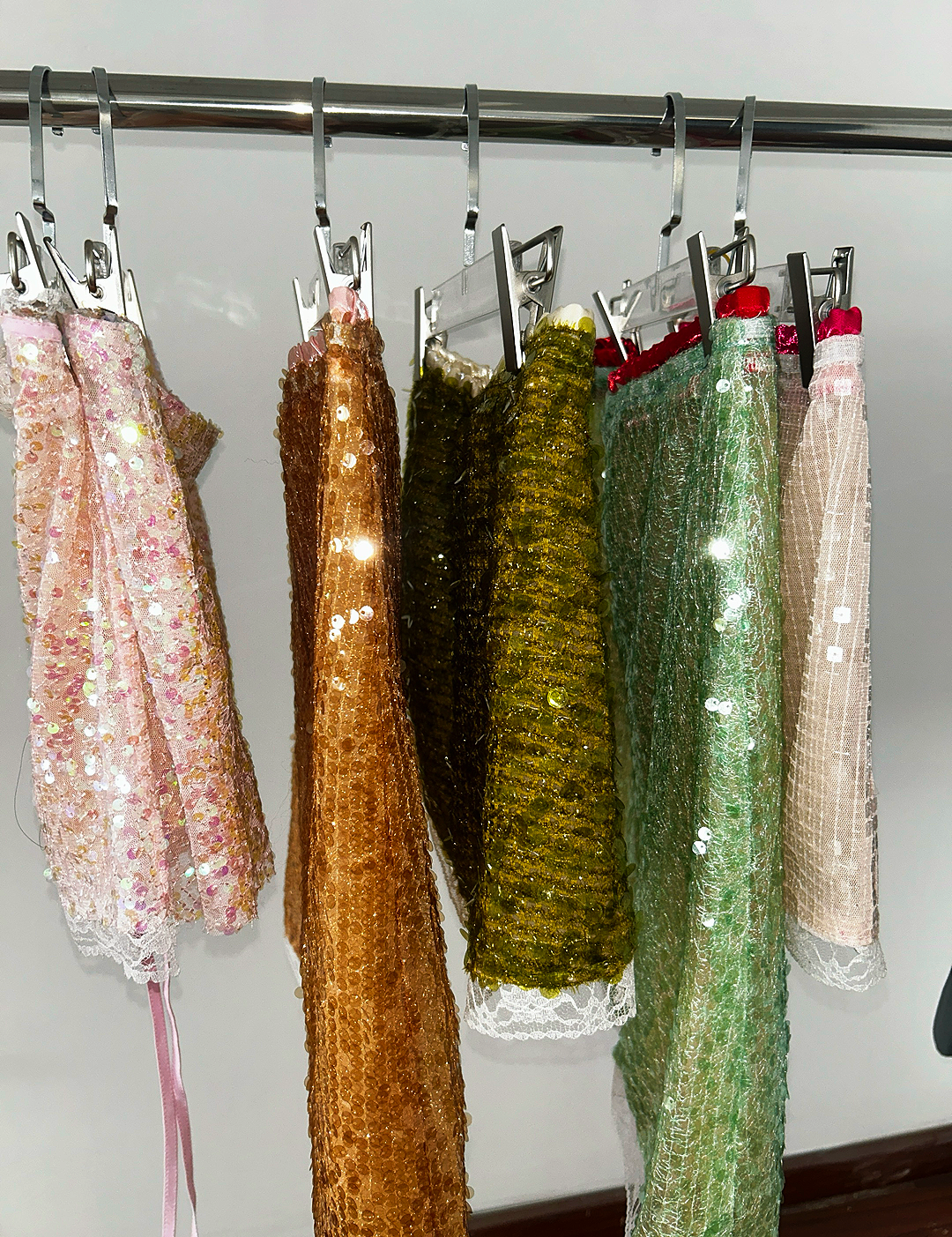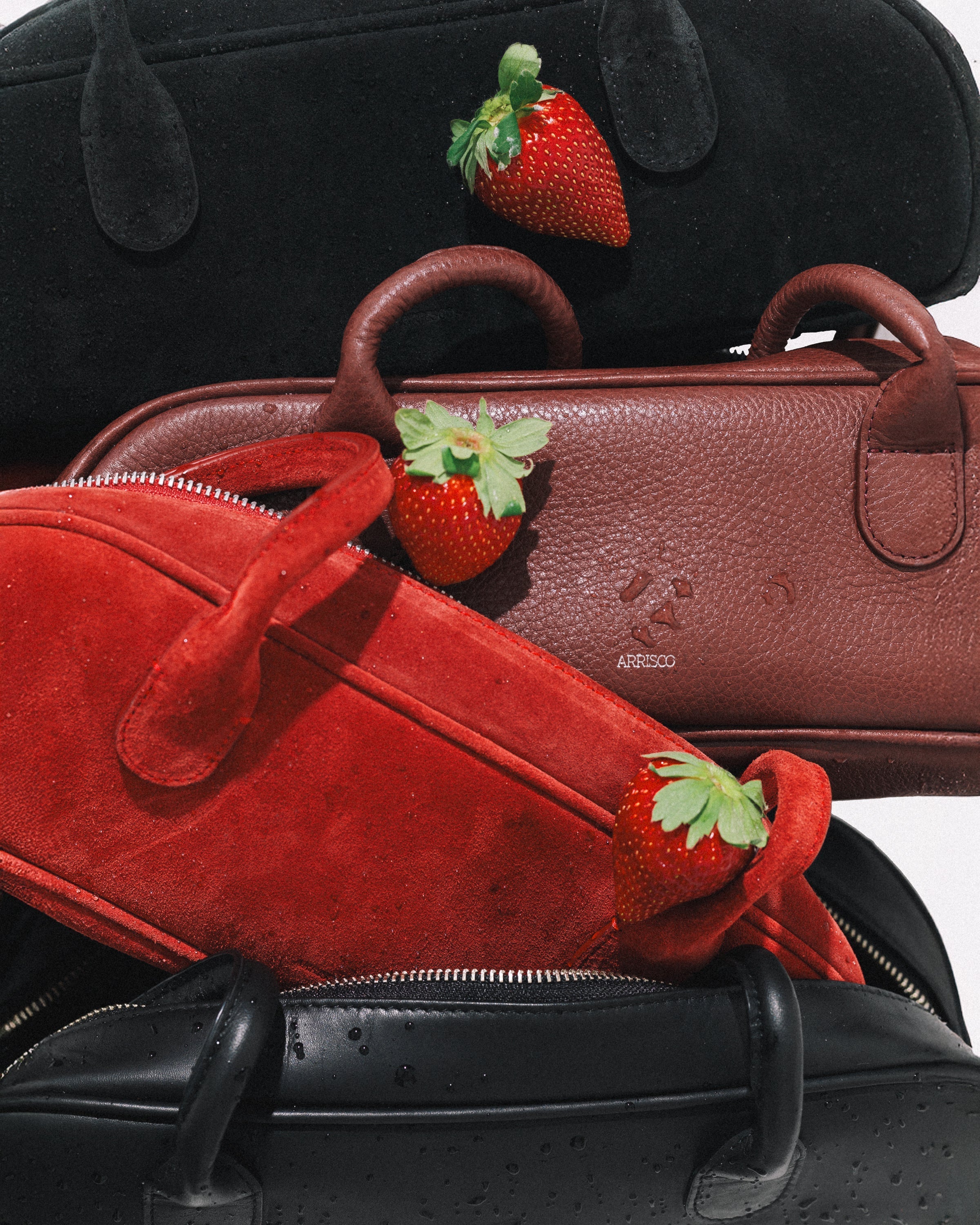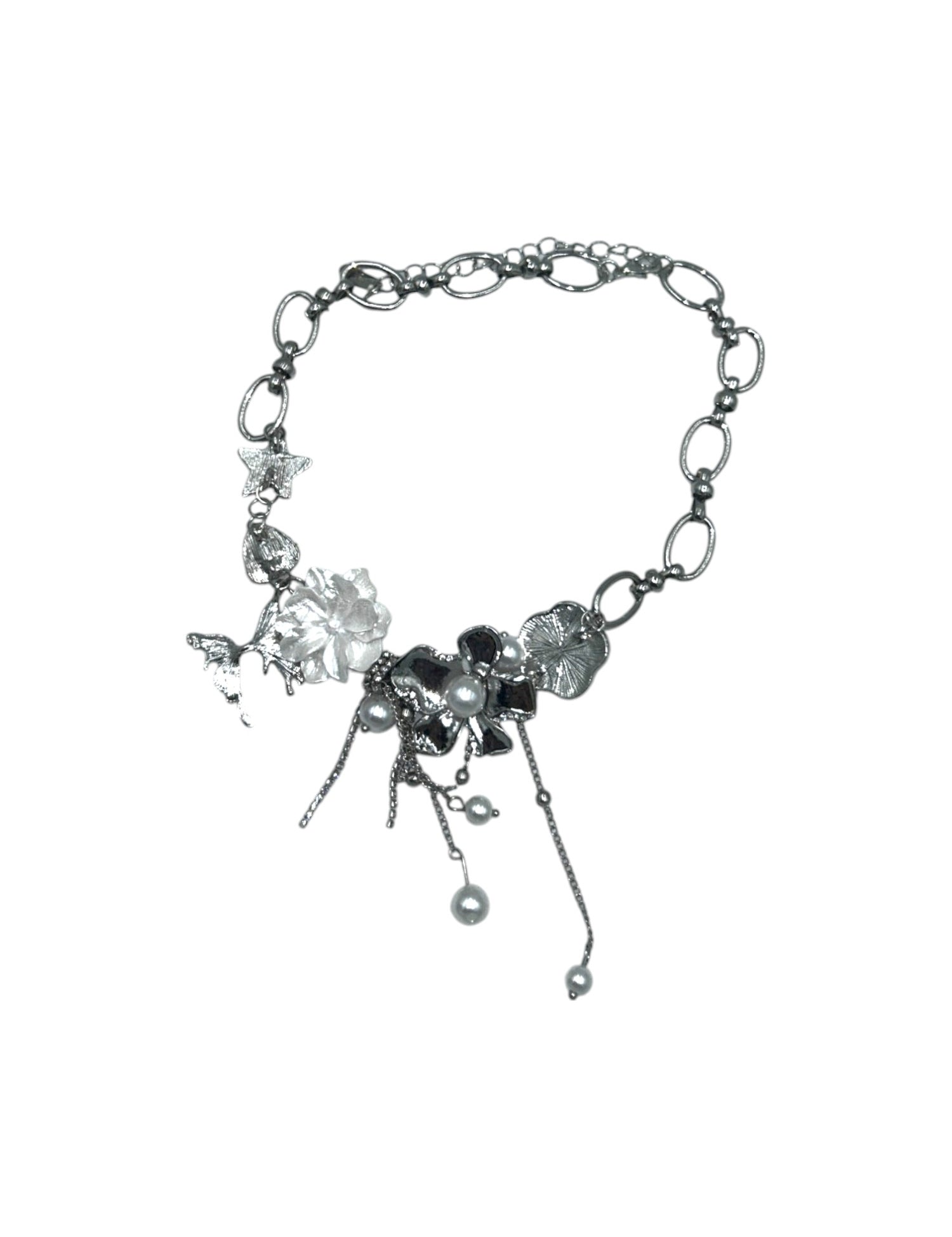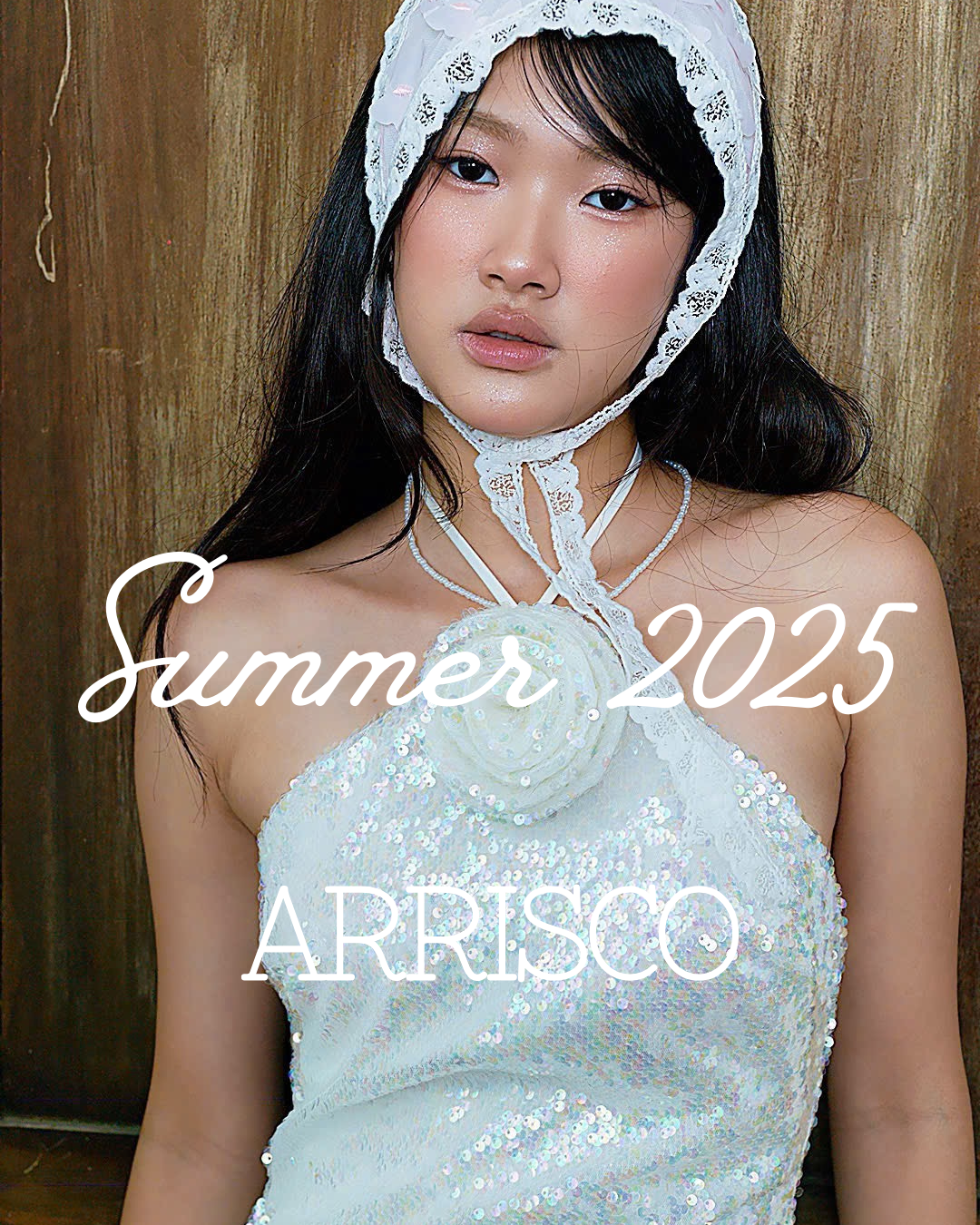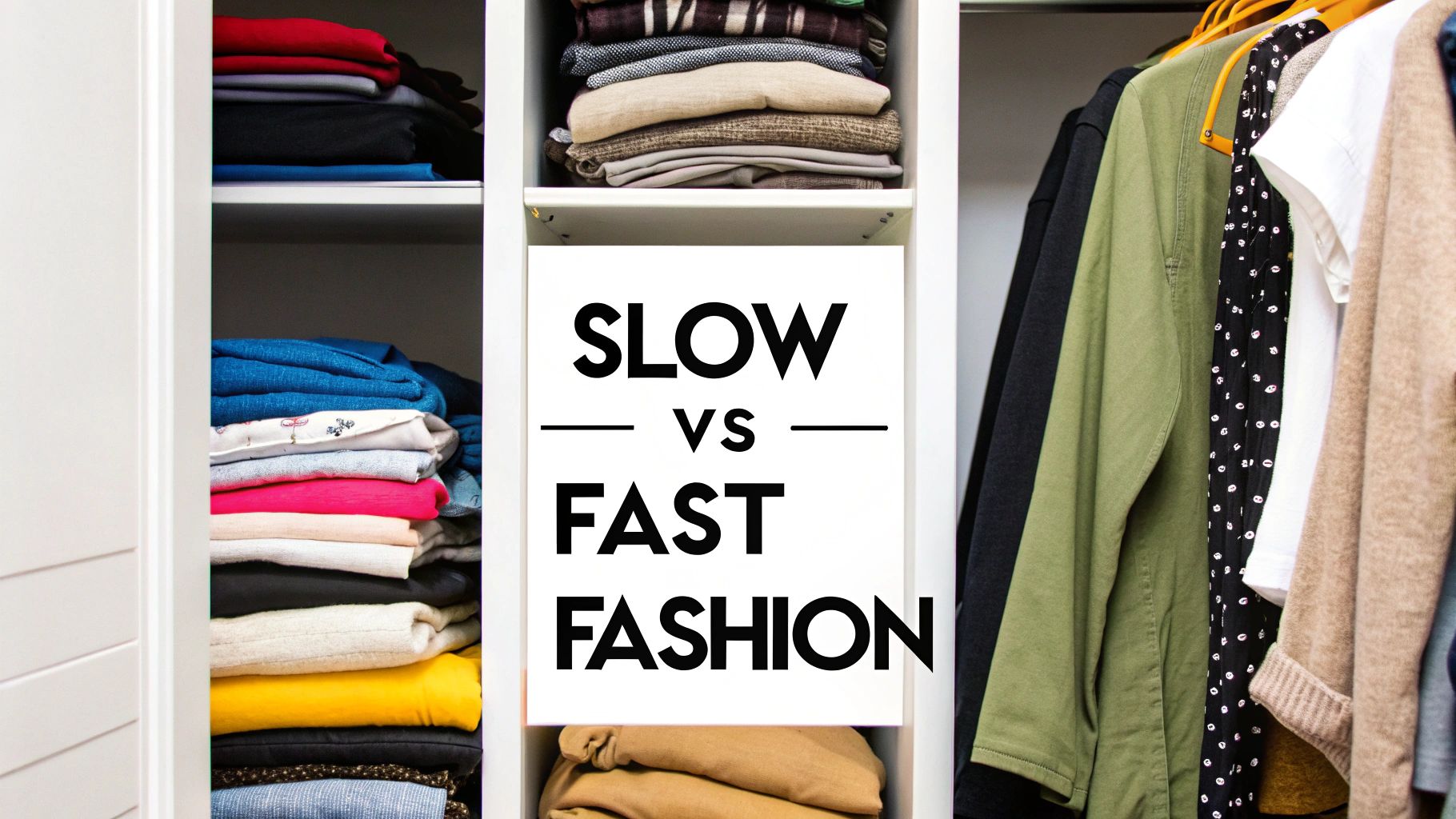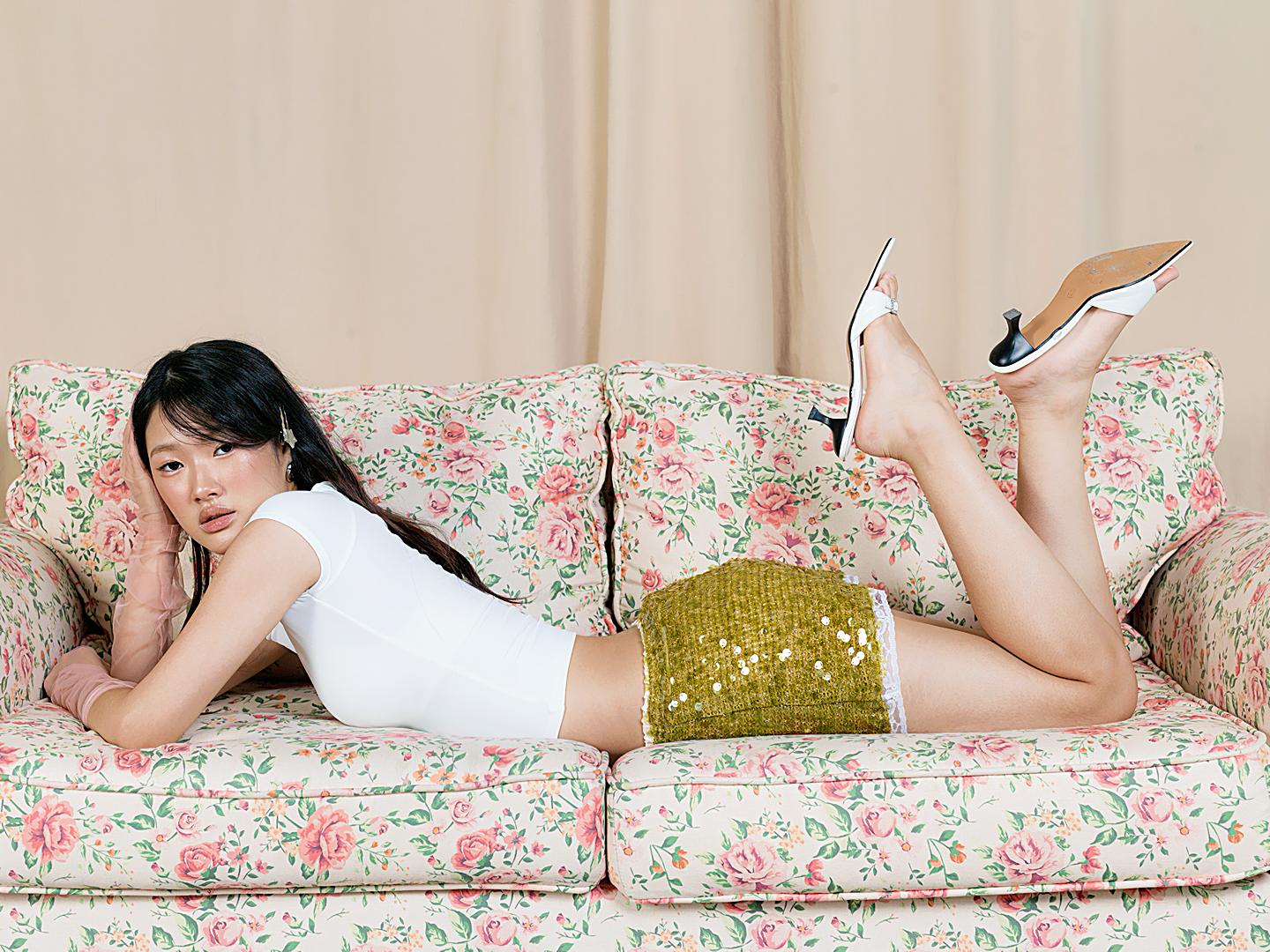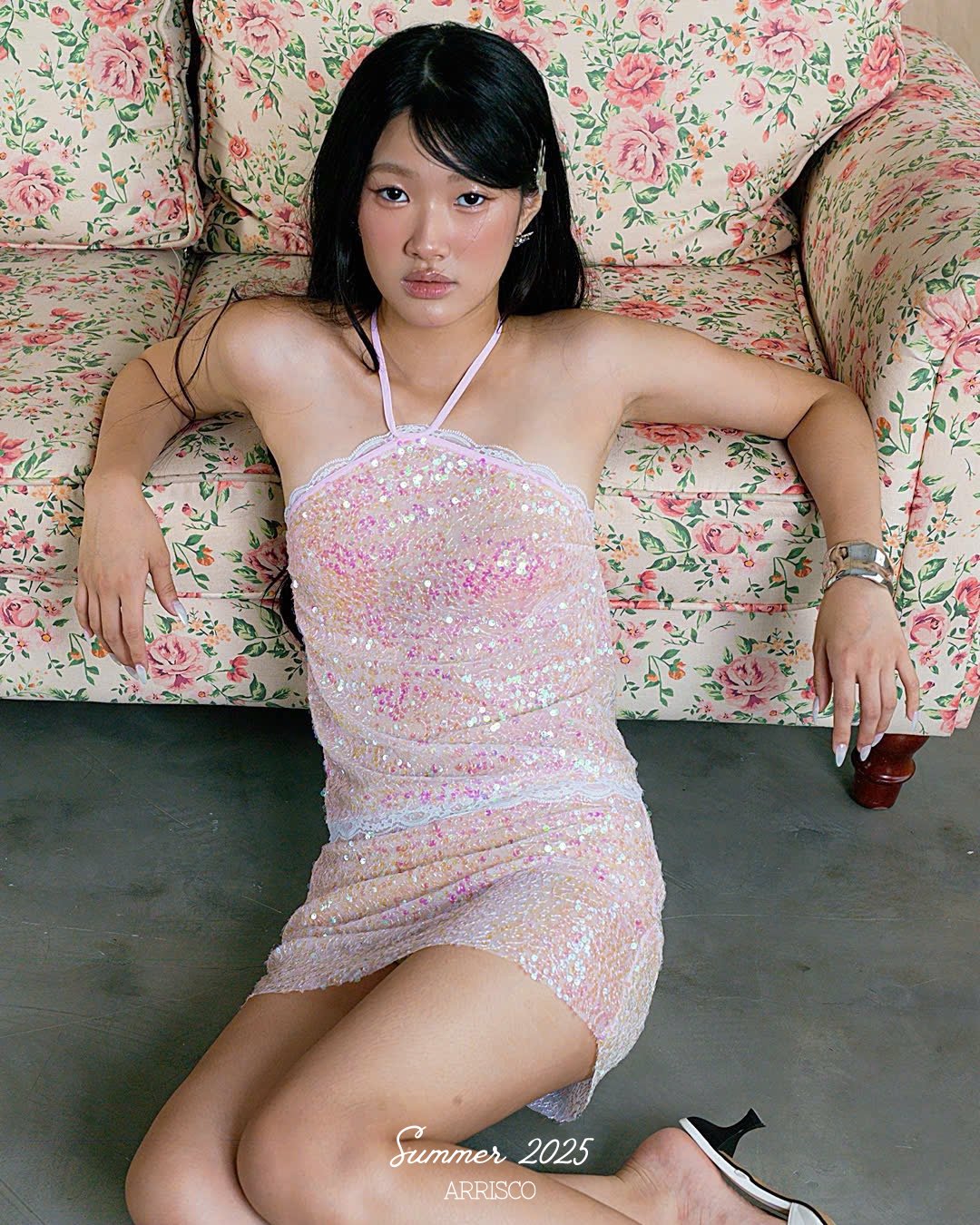When you get down to it, the slow fashion vs fast fashion debate boils down to one thing: speed. Fast fashion is built for speed and volume, while slow fashion is all about quality and intention. One is defined by its relentless, trend-driven production schedule; the other is a thoughtful movement that prioritizes timeless design, ethical production, and clothing that's made to last.
Understanding the Core Fashion Philosophies
Fast fashion runs on a model of constant newness. This isn't your parents' fashion industry with two seasons a year. We're talking about as many as 52 "micro-seasons," with some brands dropping new collections every single week. It's a hugely profitable model, too. The global fast fashion market was valued at around $150.82 billion in 2025 and is expected to soar to $214.24 billion by 2029. That kind of growth shows just how much this model resonates with shoppers. You can learn more about the explosive growth of fast fashion trends and what drives it.
Slow fashion is the direct antidote to this. Its ethos is simple: "buy less, choose well, and make it last." This philosophy isn't just about the clothes themselves but about shifting our entire mindset. It's about appreciating craftsmanship, respecting the environment, and valuing the people who make our garments.
Slow fashion asks us to think about the entire journey of our clothing—from the farm where the fiber was grown to the moment we decide to mend a loose button instead of just tossing the whole piece. It’s a return to seeing clothes as investments, not disposables.
The Two Models Side-by-Side
To really grasp how different these two approaches are, it helps to see them lined up against each other. Here’s a quick table to break down the fundamental differences, from what they’re trying to achieve to the kind of consumer behavior they encourage.
Fast Fashion vs Slow Fashion At a Glance
| Characteristic | Fast Fashion | Slow Fashion |
|---|---|---|
| Production Goal | High volume, rapid turnover | High quality, timeless appeal |
| Material Focus | Low-cost synthetics | Sustainable, natural fibers |
| Design Cycle | Weekly micro-trends | Seasonal, classic collections |
| Consumer Mindset | Disposability, trend-chasing | Investment, conscious buying |
| Labor Practices | Often opaque, low wages | Transparent, fair labor |
This table shows a clear philosophical divide. Fast fashion is a sprint, constantly chasing the next trend. Slow fashion, on the other hand, is a marathon, focused on creating something with enduring value.
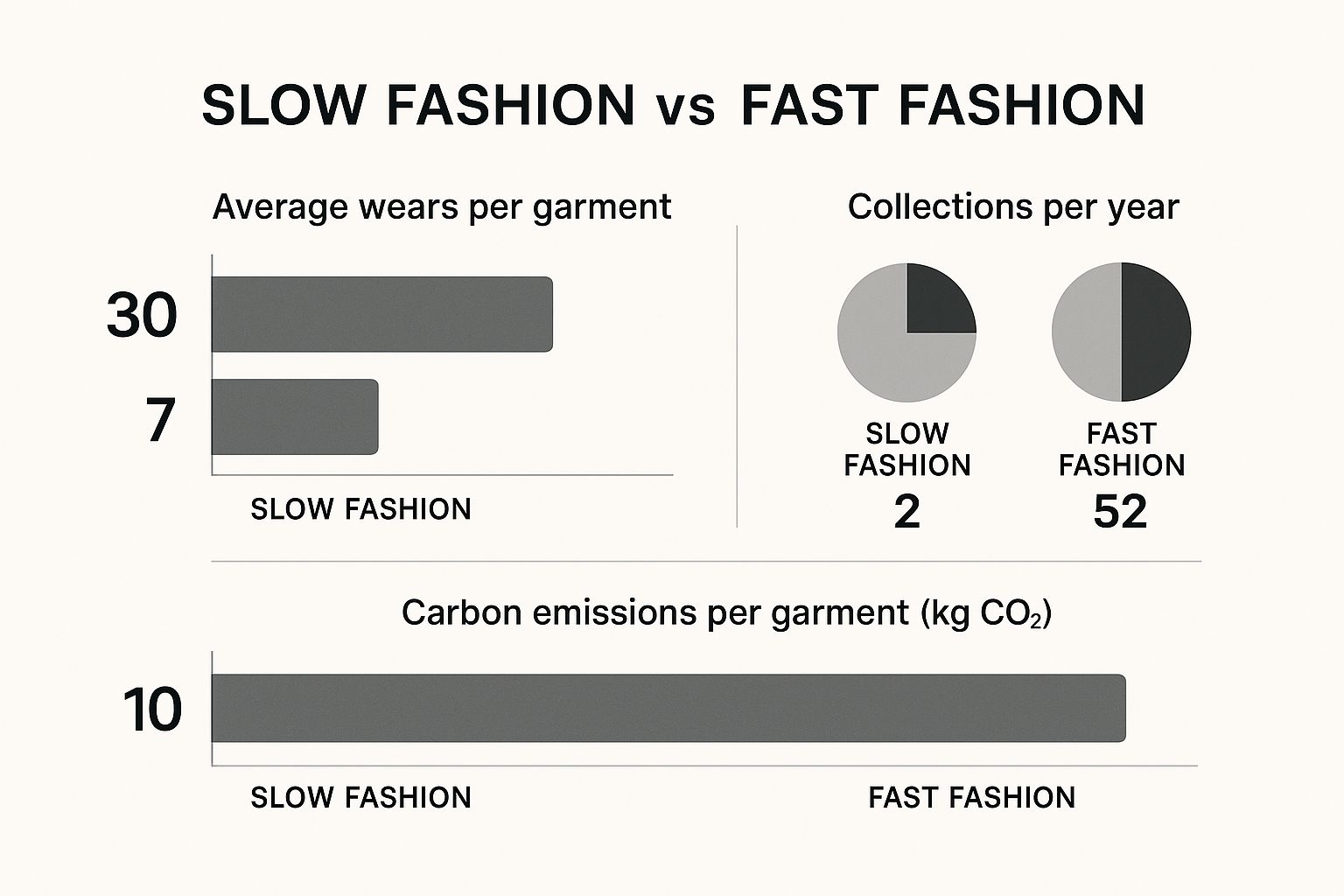
The numbers really tell the story here. The focus on durability and thoughtful production in slow fashion leads to a much smaller environmental footprint compared to the high-volume, high-waste engine of fast fashion. It's a stark contrast that highlights the true cost of our clothing choices.
Comparing the Environmental Footprint of Your Wardrobe
When you put slow and fast fashion side-by-side, the environmental toll is one of the starkest differences. Every piece of clothing has a story that starts long before it hangs in your closet, beginning with raw materials and production methods that leave a real mark on the planet.
The fast fashion model is built for speed and disposability, and its environmental footprint is notoriously huge. It leans heavily on synthetic fabrics like polyester, nylon, and acrylic—all of which are made from fossil fuels. This directly fuels the microplastic pollution crisis. Each time you wash these garments, they shed tiny plastic fibers that slip into our waterways, eventually piling up in oceans and ecosystems.
The Scale of the Impact
The industry’s appetite for resources is simply staggering. Fast fashion has become a global problem, responsible for about 10% of the world's carbon emissions. To put that in perspective, that’s more than all international flights and maritime shipping combined. On top of that, it guzzles massive amounts of water and creates incredible waste—an estimated 85% of all textiles are thrown into landfills each year. You can dig deeper into the alarming statistics of fast fashion on UniformMarket.com.
This relentless cycle of overproduction and waste is what defines the short, frantic life of a typical fast fashion piece.
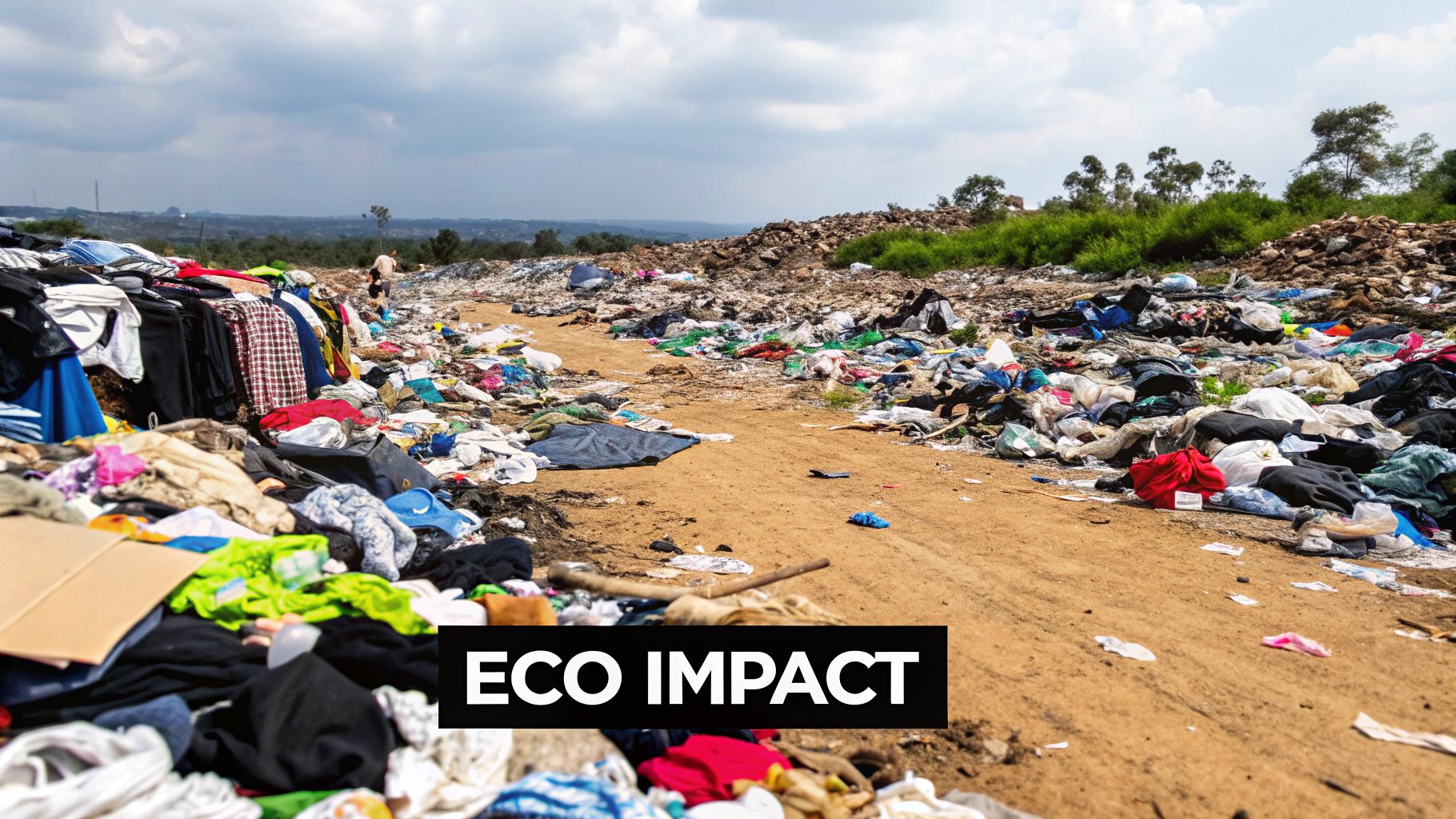
This image really drives home the linear "take-make-dispose" model that the industry runs on. It's a system with almost no recycling built-in and a massive output of landfill-bound trash. The whole point is to produce and consume as quickly as possible, not to create a circular, sustainable life for our clothes.
A More Sustainable Approach
Slow fashion, on the other hand, champions a totally different relationship with the environment. It's all about choosing materials that are renewable, biodegradable, or recycled, which dramatically cuts down the ecological burden right from the get-go.
Some of the go-to sustainable materials in slow fashion include:
- Organic Cotton: It's grown without nasty pesticides and synthetic fertilizers, and it uses way less water than its conventional counterpart.
- Linen: Made from the flax plant, linen is incredibly durable, biodegradable, and needs very little water or pesticides to grow.
- Recycled Fibers: Using materials like recycled polyester (rPET) or reclaimed wool gives existing resources a second chance, keeping them out of landfills.
Slow fashion’s environmental edge isn't just about better materials; it's about a different mindset. By producing smaller, more thoughtful collections, these brands automatically cut down on waste, energy, and emissions at every step.
This approach doesn't just reduce the harm; it encourages us to be more conscious consumers. It’s a perfect fit for building a timeless wardrobe where you choose pieces for their lasting quality and style. Think about pairing a classic linen shirt with some enduring accessories—a look that sidesteps fleeting trends. For some inspiration, you might want to check out our guide on the top accessory trends for 2025 that work beautifully with a sustainable wardrobe.
In the end, choosing between these two models really comes down to what kind of environmental legacy you want your closet to have. One path fuels resource depletion and pollution, while the other helps build a more mindful and regenerative relationship with the clothes we wear.
Analyzing the Human Cost of Clothing Production
Beyond the environmental toll, perhaps the most jarring difference between slow and fast fashion is the human one. The fast fashion model is built for speed and rock-bottom prices, but that speed often comes at a steep, and very human, cost. This entire system leans on a complicated and intentionally murky global supply chain, where the pressure to churn out new styles cheaply gets passed all the way down to the factory floor.
The result? A long, well-documented history of labor exploitation. Garment workers, who are mostly women in developing countries, are often trapped in a cycle of grueling hours, unsafe working conditions, and wages that don't even come close to a livable income. The non-stop demand for new inventory means corners get cut—not just on fabric quality, but on basic human safety and dignity.
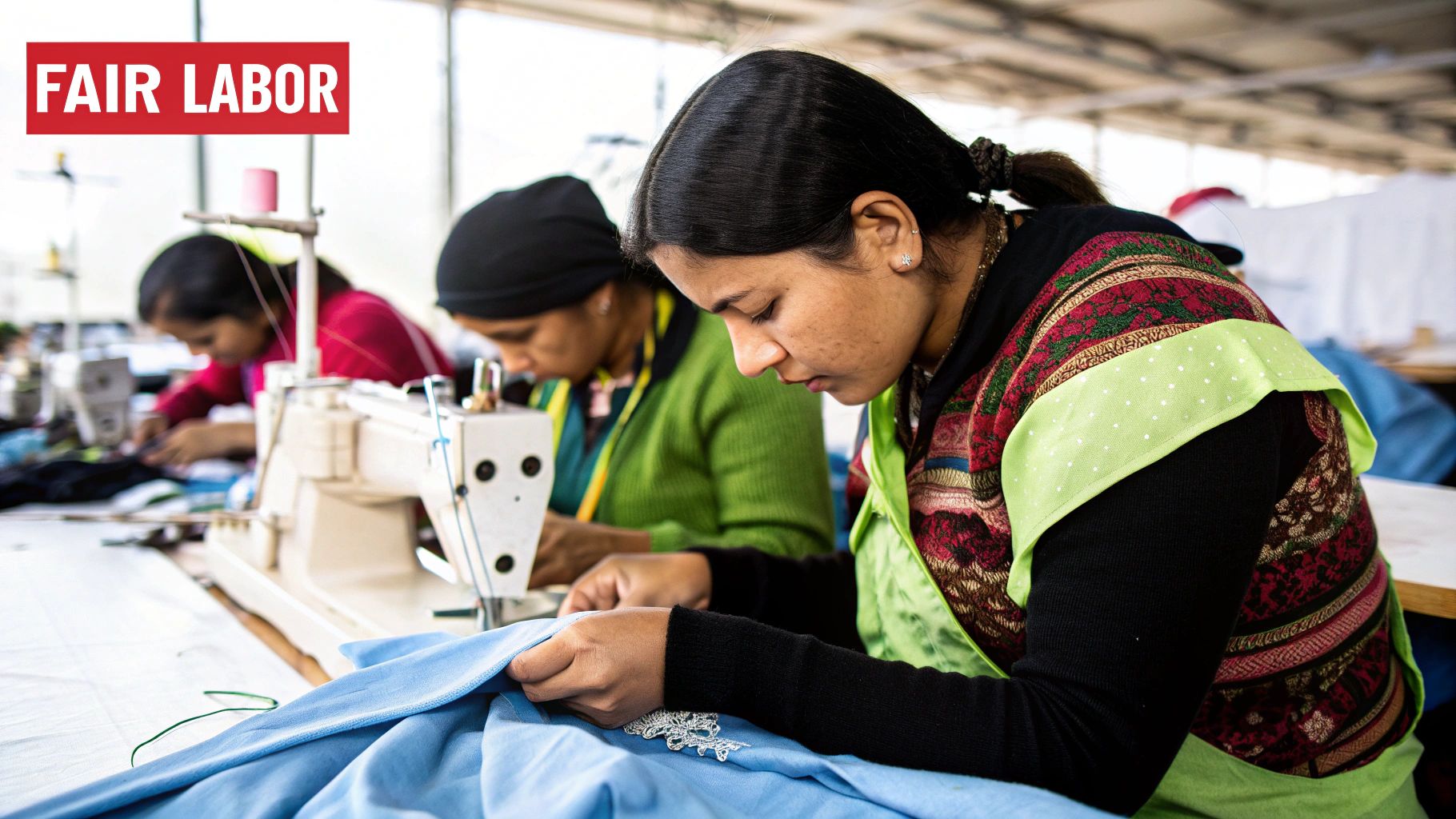
The Slow Fashion Ethical Framework
Slow fashion operates on a completely different philosophy. It puts people right alongside the planet, championing an ethical framework built on a simple principle: the person who made your clothes deserves respect, fair pay, and a safe place to work. It’s a movement that celebrates craftsmanship and the skills of artisans, turning away from the disposable mindset that fast fashion applies to both its clothes and its workers.
So, how do slow fashion brands actually pull this off? It boils down to a few core practices:
- Radical Transparency: They’re not afraid to pull back the curtain. They openly share details about their factories, how their clothes are made, and even their wage structures.
- Fair Wages: This is non-negotiable. They commit to paying a living wage that actually covers a person's basic needs and provides a decent standard of living.
- Safe Conditions: They partner with factories that meet high safety standards, actively preventing the kind of hazardous conditions that have become tragically common in fast fashion.
This commitment to doing right by their workers isn't just a promise; it's often verified by independent, third-party certifications. These labels give you a clear, trustworthy sign that a brand is actually living up to its claims.
Think of certifications like Fair Trade and B Corp as your guarantee. They independently confirm that a brand meets strict social and environmental standards, helping you see past the "greenwashing" and know that your money is truly supporting ethical practices.
Making Informed and Ethical Choices
Every time you choose to buy from a brand that upholds these standards, you're casting a vote with your wallet for a better, more equitable fashion industry.
You'll often find that when a brand is serious about quality materials and craftsmanship, better labor practices naturally follow. For example, the conversation around real leather and why it’s worth it is often tied to the skilled artisanship it requires—a hallmark of more ethical, slow production.
Ultimately, digging into the human cost changes the conversation. It’s no longer just about what we're wearing, but how it was made and who made it. This awareness fosters a much deeper connection to our clothes, helping us see the human hands and stories behind each piece and empowering us to support a system that values every single person in the supply chain.
Evaluating Long-Term Value Over Initial Cost
The price tag is often the first thing our eyes jump to, but it rarely tells the whole story. When you're weighing slow fashion against fast fashion, that initial cost can be seriously misleading. A super low price on a fast fashion top feels like a steal, but that "deal" comes at a hidden cost: cheap materials and rushed production.
This whole business model is built for a short lifespan. These garments are often made from flimsy synthetic fabrics with stitching that gives up after a few washes. It’s not an accident; it's a feature. This built-in obsolescence keeps you trapped in a cycle of buying, discarding, and buying again to keep up with the next micro-trend.
Shifting Focus to Cost Per Wear
Slow fashion encourages a totally different way of thinking about value. Sure, a beautifully made piece from a conscious brand costs more upfront, but it's better to see it as a long-term investment in your wardrobe. The trick is to look past the price tag and think about the cost per wear.
It’s a simple metric that uncovers the true value of your clothes over time. You just divide the total price of an item by the number of times you actually wear it. That cheap, trendy shirt might seem like a bargain, but if it only survives a handful of outings before it looks worn out, its cost per wear can be surprisingly high.
A higher upfront cost on a timeless, durable piece often translates to a much lower cost per wear over its lifetime. This perspective transforms a purchase from a disposable expense into a smart, sustainable investment.
A Practical Cost Comparison
Let's put this into perspective with a real-world example. Imagine you're in the market for a new winter coat and you're choosing between a classic, well-made wool coat from a slow fashion brand and a trendy, cheaper alternative from a fast fashion giant. The long-term math might surprise you.
Cost Per Wear Analysis: A Practical Example
This table breaks down how a quality slow fashion piece can actually be more economical over time compared to repeatedly buying its fast fashion equivalent.
| Item | Initial Cost | Estimated Wears | Cost Per Wear |
|---|---|---|---|
| Fast Fashion Coat | $75 | 30 (1-2 seasons) | $2.50 |
| Slow Fashion Coat | $300 | 200 (5+ years) | $1.50 |
As you can see, the initial sticker shock of the slow fashion coat completely disappears when you factor in its longevity. Over several years, it not only gives you better quality and timeless style but also ends up being the smarter financial choice. Its cost per wear is significantly lower because it was actually built to last, not to be replaced.
This shift in mindset is what embracing slow fashion is all about. It’s about understanding that quality materials and ethical craftsmanship deliver a value that goes far beyond the initial purchase price. By choosing durability and classic design, you're not just building a more sustainable wardrobe—you're making smarter financial decisions that pay dividends for years to come.
How to Build a More Conscious Wardrobe
Making the switch from fast to slow fashion isn’t about a massive, overnight closet purge. Think of it more as a gradual, intentional shift in how you think about clothes. The journey actually starts not with buying anything new, but by taking a good, hard look at what you already own.
Go through your closet and do a real wardrobe audit. Get a feel for every piece, paying attention to what you genuinely love and wear all the time. This simple step helps you reconnect with your current collection, often unearthing forgotten favorites and clarifying what your personal style really is, outside of fleeting trends. It all comes down to a powerful philosophy: buy less, but choose well.
Starting Your Slow Fashion Journey
Breaking the process down into smaller, manageable steps makes the whole thing feel much less daunting. You don't have to overhaul everything at once; even tiny changes add up to a huge impact over time. The goal is to build habits that put longevity and mindfulness first.
A fantastic place to start is by learning some basic mending skills. Knowing how to sew on a button or patch a small tear can dramatically extend the life of your most-loved clothes, which saves you money and cuts down on waste. It’s a foundational skill in the slow fashion world, turning you from a passive consumer into an active caretaker of your wardrobe.
The real heart of the slow vs. fast fashion debate is intentionality. Slow fashion is a mindful approach—it’s about sustainability, ethical labor, and environmental care. It's a move away from seeing clothes as disposable.
Smart Strategies for Conscious Shopping
When you do decide it's time to bring something new into your closet, shop with a purpose. This is the opposite of the impulse buy that fast fashion retailers count on. Instead, you're looking for pieces that will genuinely add value to your life and your style for years to come.
Here are a few practical ways to shop more consciously:
- Identify Authentic Brands: Look for brands that are transparent. A true slow fashion brand won't hide its supply chain; it will openly share details about its factories and materials. Certifications like GOTS (Global Organic Textile Standard) or Fair Trade are great indicators, as they provide third-party proof of a company's ethical claims.
- Explore Secondhand Options: Thrifting and consignment shopping are your best friends. You can find incredible, high-quality, and unique pieces without contributing to the demand for new production. It’s fashion recycling at its finest.
- Consider Rentals and Swaps: Got a wedding or a big event? Renting an outfit is a brilliant, sustainable alternative to buying something you’ll likely wear only once. Clothing swaps with friends or in your community are another fun, free way to refresh your wardrobe.
Putting these strategies into practice helps you build a wardrobe that not only looks great but also feels right because it aligns with your values. For more inspiration on this topic, check out our complete guide to sustainable fashion and redefining style.
Answering Your Questions About Adopting Slow Fashion
Making the switch from the instant-gratification rush of fast fashion to a more thoughtful approach can feel like a big leap. It naturally brings up a lot of practical questions and maybe a few doubts. The good news? Adopting a slow fashion mindset is less about a massive, overnight overhaul and more about making small, intentional choices that add up. It's a journey anyone can start.
This section is all about tackling those common questions and hurdles that pop up when you start looking beyond disposable trends.
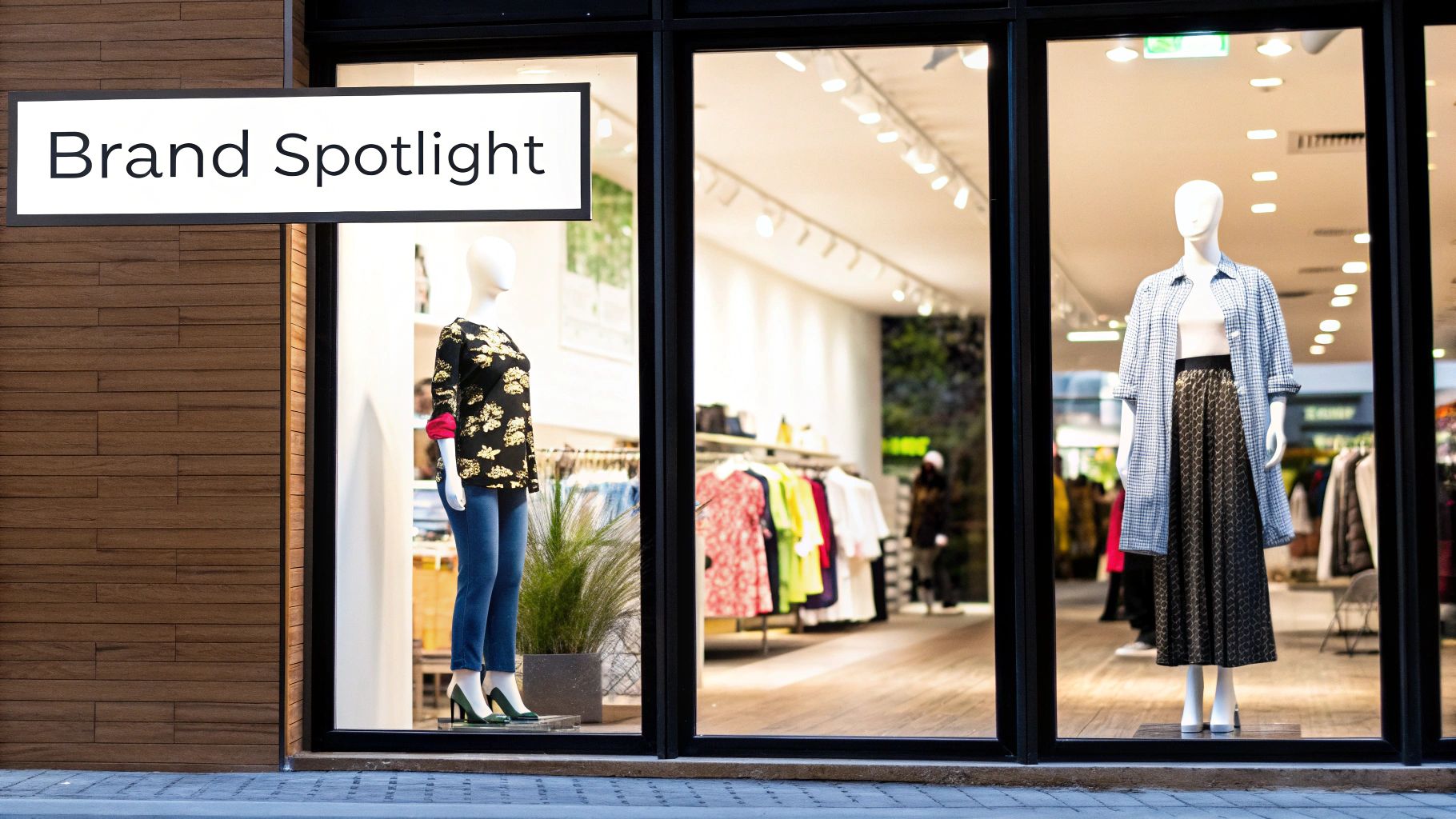
Can I Still Follow Trends with Slow Fashion?
Absolutely. The difference isn't about ignoring trends; it's about how you engage with them. Instead of chasing down every micro-trend that flashes across your screen, slow fashion is about building a strong foundation of personal style first.
Once you have that core wardrobe, you can still bring in current elements, just more thoughtfully. Maybe you add a popular color or a new silhouette through one beautifully made piece that you know you'll love for years. Accessories are another brilliant way to play with trends without the commitment, giving a modern edge to a classic outfit.
Is Slow Fashion Only for the Wealthy?
This is probably the biggest myth out there. While a single slow fashion piece might have a higher price tag upfront, the whole philosophy is actually incredibly budget-friendly. Its central ideas—buy less, repair what you own, and shop secondhand—are powerful ways to save money.
Think of it in terms of cost per wear. A well-made coat that you wear for a decade is a much smarter investment than a cheap jacket that falls apart after one season. The focus shifts from the initial price to long-term value, which often makes slow fashion the more economical choice over time.
Slow fashion isn't some exclusive club for people with expensive taste. It's a mindset built on resourcefulness. It encourages things like clothing swaps, mending, and thrifting, all of which are accessible no matter your budget.
How Can I Spot Greenwashing and Find Truly Ethical Brands?
Figuring out which brands are genuine requires a bit of detective work. The single most reliable sign of an ethical brand is radical transparency. Vague, feel-good terms like "eco-friendly" or "conscious" mean almost nothing without proof to back them up.
A truly sustainable brand won't be shy about sharing specific, verifiable details about how its clothes are made. Look for these green flags:
- Detailed Factory Information: They'll tell you where their factories are and share information about the working conditions.
- Material Sourcing: They're specific about the origin and makeup of their fabrics, not just calling something "sustainable."
- Third-Party Certifications: Look for credible seals of approval like GOTS (Global Organic Textile Standard), Fair Trade, or B Corp. These organizations independently verify a company's claims.
If a brand is cagey with the details, that's often a red flag. A lack of specific information usually means there’s something they’d rather you not see.
What Is the Most Impactful First Step I Can Take?
The most powerful thing you can do costs nothing and doesn't require buying anything new. Just pause before you buy. The fast fashion business model is built on impulse, pushing you to click "add to cart" without a second thought. Breaking that habit is a game-changer.
Before you make a purchase, ask yourself a few direct questions:
- Do I genuinely need this, or am I just buying on a whim?
- Can I realistically see myself wearing this at least 30 times?
- Does this piece fit my personal style, or am I just chasing a fleeting trend?
This simple act of pausing interrupts the cycle of mindless consumption. It helps you cut down on waste and saves your money for the high-quality pieces you'll truly love for years to come.
At Arrisco, we believe in the power of conscious choices and timeless style. Our curated collections are designed with quality and longevity in mind, offering pieces that you can treasure season after season. Discover a more intentional way to shop by exploring our latest arrivals and building a wardrobe that reflects both your style and your values. https://shoparrisco.com

